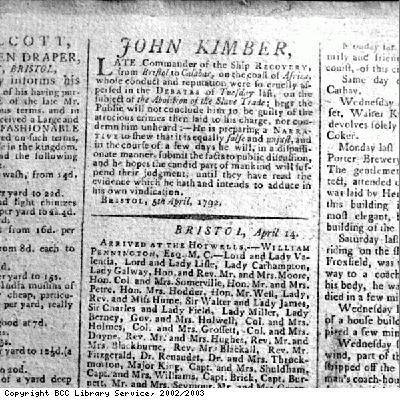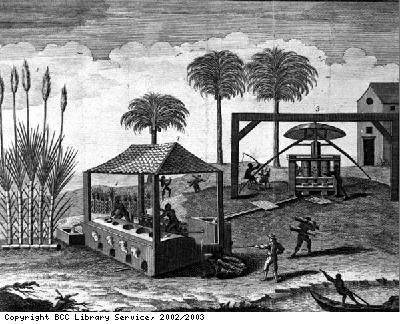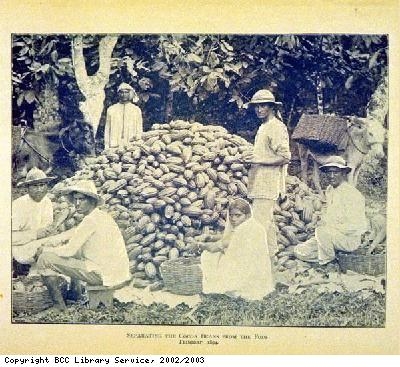Page 279 of 352 pages « First < 277 278 279 280 281 > Last »
John Kimber’s announcement

Description:
John Kimber’s announcement, Felix Farley’s Bristol Journal ,1792. Captain Kimber denied flogging a slave girl because she was unwell and couldn’t eat.
Date: 1792
Copyright: Copyright BCC Library Service
Sugar works

Description:
Representation of a sugar works, from Universal Magazine, 1750
Creator: Universal Magazine
Date: 1750
Copyright: Copyright BCC Library Service
Adverts for shops

Description:
Advertisements from Felix Farley’s Bristol Journal , for shops owned by Mary Darvill (sugar loaf, chocolate) and John Woodhouse (tobacco).
Cocoa, which was used to make chocolate, was grown on slave planations in the Caribbean and brought to Bristol for processing.
Chocolate was first used as a drink, sweetened with sugar to mask the bitter flavour of the chocolate. Later it was used for making eating chocolate. At this period, most people drank beer, wine or spirits. Water was not safe to drink, tea coffee and chocolate were expensive. Quakers promoted drinking chocolate as an alternative to alcohol.
Creator: Mary Darvill/ John Woodhouse
Copyright: Copyright BCC Library Service
Shipping news from local paper

Description:
Just Imported notice in a Bristol newspaper, reporting on goods going from Bristol to the Caribbean island of Jamaica, in 1784. The goods include Negro cloathing and blankets and double Gloucester cheeses.
The language used to describe people of African descent in the 18th, 19th and 20th centuries is unacceptable in today’s terms. We cannot avoid using this language in its original context. To change the words would impose 20th century attitudes on history.
Date: 1784
Copyright: Copyright BCC Library Service
Splitting cocoa pods

Description:
Splitting pods, from Historicus, Cocoa: All About It , 1896. Cocoa beans were used in the chocolate making process.
Cocoa, which was used to make chocolate, was grown on slave planations in the Caribbean and brought to Bristol for processing.
Chocolate was first used as a drink, sweetened with sugar to mask the bitter flavour of the chocolate. Later it was used for making eating chocolate. At this period, most people drank beer, wine or spirits. Water was not safe to drink, tea coffee and chocolate were expensive. Quakers promoted drinking chocolate as an alternative to alcohol.
Creator: Historicus, Cocoa: All About It
Date: 1896
Copyright: Copyright BCC Library Service
Tools for harvesting cocoa

Description:
Specialist tools for harvesting cocoa, from Historicus, Cocoa: All About It , 1896.Cocoa beans were used in the chocolate making process.
Cocoa, which was used to make chocolate, was grown on slave planations in the Caribbean and brought to Bristol for processing.
Chocolate was first used as a drink, sweetened with sugar to mask the bitter flavour of the chocolate. Later it was used for making eating chocolate. At this period, most people drank beer, wine or spirits. Water was not safe to drink, tea coffee and chocolate were expensive. Quakers promoted drinking chocolate as an alternative to alcohol.
Creator: Historicus, Cocoa: All About It
Date: 1896
Copyright: Copyright BCC Library Service
Letterhead of Bristol Fire Office

Description:
Letterhead of the Bristol Fire Office
Creator: Fire Insurance Office
Date: unknown
Copyright: Copyright BCC Library Service
Poster for Theatre Royal, Bristol

Description:
Poster for the Theatre Royal, Bristol, The Slave
Creator: Theatre Royal
Date: unknown
Copyright: Copyright BCC Library Service
Theatre Royal Advert
Description:
Advertisement for Inkle and Yarico at the Theatre Royal, Felix Farley’s Bristol Journal , 1792.
An Indian woman is sold into slavery on Barbados by the man she had rescued and protected from her countrymen when he was shipwrecked. He then repented of his action towards the woman he had loved, redeemed her and married her.
Inkle and Yarico is a comic opera, which was written by George Colman the Younger in 1787. It is based on a supposedly true story told in Richard Ligons True and Exact History of the Island of Barbados.
A young man was shipwrecked on the South American coast and his life was saved by a young Indian woman.
He got off the island, taking her with him, and then sold her into slavery in Barbados.
This story was romanticised by Steele, writing in the Spectator in 1711.
Colman adapted Steeles story into his comic opera. It was very popular and was performed many times at different London theatres.
In Colmans version, Thomas Inkle, a young Englishman, is taking his fiance out to her father, the Governor of Barbados.
He is lost overboard with his servant and is marooned on an island.
They are saved from the cannibal locals by a young Indian woman, Yarico, and her servant.
Inkle and Yarico fall in love. Inkle and Yaricos servants also fall in love with each other.
Inkle promises undying love to Yarico.
They are taken off the island by a British boat and taken to Barbados.
There, Inkle is reintroduced to civilised life and realises his position.
He applies economic theory rather than love to his situation, by choosing his fiance and selling Yarico as a slave.
His servant refuses to sell his Indian lover as a slave.
Inkle is then humiliated for his ingratatitude and betrayal of Yarico, repents his behaviour and marries her.
This story was romanticised by Steele, writing in the Spectator in 1711.
Colman adapted Steeles story into his comic opera. It was very popular and was performed many times at different London theatres.
In Colmans version, Thomas Inkle, a young Englishman, is taking his fiance out to her father, the Governor of Barbados.
He is lost overboard with his servant and is marooned on an island.
They are saved from the cannibal locals by a young Indian woman, Yarico, and her servant.
Inkle and Yarico fall in love. Inkle and Yaricos servants also fall in love with each other.
Inkle promises undying love to Yarico.
They are taken off the island by a British boat and taken to Barbados.
There, Inkle is reintroduced to civilised life and realises his position.
He applies economic theory rather than love to his situation, by choosing his fiance and selling Yarico as a slave.
His servant refuses to sell his Indian lover as a slave.
Inkle is then humiliated for his ingratatitude and betrayal of Yarico, repents his behaviour and marries her.
Creator: Theatre Royal
Date: 1792
Copyright: Copyright BCC Library Service
Extract newspaper

Description:
Imported this week column, bees’ wax, camwood, elephants’ teeth, mahogany. Felix Farley’s Bristol Journal, 1793
Creator: Felix Farley's Bristol Journal
Date: 1793
Copyright: Copyright BCC Library Service
Page 279 of 352 pages « First < 277 278 279 280 281 > Last »

